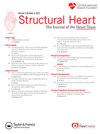严重三尖瓣反流患者的真实世界临床结果和医疗保健利用
IF 1.4
Q3 CARDIAC & CARDIOVASCULAR SYSTEMS
引用次数: 0
摘要
背景:严重三尖瓣反流(TR)患者有显著的发病率和死亡率风险。关于这一人群的长期临床结果和卫生保健资源利用的数据有限。方法:我们使用Optum Market Clarity数据库,从2016年到2022年,根据医生文件、严重TR的索赔和诊断后3个月内的超声心动图,识别严重TR患者。通过3年随访,使用Kaplan-Meier方法计算事件发生率,使用Bang和Tsiatis审查方法计算卫生保健资源使用和支出。对有严重症状的TR患者进行了二次分析,这些患者需要额外的预先规定的体征或症状的医生记录。结果在2016年至2022年期间,我们确定了1190例患有严重TR且未进行过三尖瓣手术的患者。平均年龄72岁,67%为女性。基线合并症很常见,平均Elixhauser评分为9.4±4.0(范围0-31)。在有详细超声心动图资料的患者中(N = 322), 46%的左室射血分数正常。三年的全因死亡率、中风和任何三尖瓣手术分别为47.9%、19.1%和7.5%。与保健有关的资源利用率很高,每名患者3年累计费用约为127 000美元。结论在3年的随访中,严重TR患者的死亡率和不良临床事件发生率较高,且产生了大量的医疗费用。为了更好地了解这些新疗法的价值,需要关于经导管介入治疗严重TR对临床结果和成本影响的长期数据。本文章由计算机程序翻译,如有差异,请以英文原文为准。
Real-World Clinical Outcomes and Health Care Utilization in Patients With Severe Tricuspid Regurgitation
Background
Patients with severe tricuspid regurgitation (TR) are at risk for significant morbidity and mortality. Data on long-term clinical outcomes and health care resource utilization for this population are limited.
Methods
We used the Optum Market Clarity database from 2016 to 2022 to identify patients with severe TR based on a combination of physician documentation, claims for severe TR, and echocardiography within 3 months of the diagnosis. Event rates through 3-year follow-up were calculated using Kaplan-Meier methodology, and health care resource use and expenditures were calculated using the Bang and Tsiatis censoring method. Secondary analyses were performed among patients with severe, symptomatic TR, which required additional physician documentation of prespecified signs or symptoms.
Results
We identified 1190 patients with severe TR and no previous tricuspid valve surgery between 2016 and 2022. The mean age was 72 years, and 67% were female. Baseline comorbidities were common, with a mean Elixhauser score of 9.4 ± 4.0 (range, 0-31). Of patients with detailed echocardiographic data available (N = 322), 46% had normal left ventricular ejection fraction. Three-year rates of all-cause mortality, stroke, and any tricuspid valve surgery were 47.9, 19.1, and 7.5%, respectively. Health care–related resource utilization was high, with cumulative 3-year costs of approximately $127,000/patient.
Conclusions
Over 3 years of follow-up, patients with severe TR had high rates of death and adverse clinical events and incurred substantial health care costs. Longer-term data regarding the impact of transcatheter interventions for severe TR on clinical outcomes and costs are needed to better understand the value of these novel therapies.
求助全文
通过发布文献求助,成功后即可免费获取论文全文。
去求助
来源期刊

Structural Heart
Medicine-Cardiology and Cardiovascular Medicine
CiteScore
1.60
自引率
0.00%
发文量
81
 求助内容:
求助内容: 应助结果提醒方式:
应助结果提醒方式:


